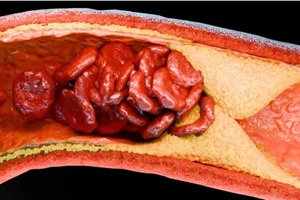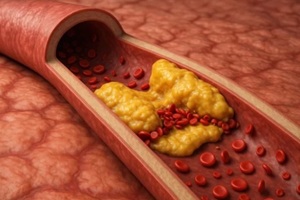 Mixed hyperlipidemia is a genetic condition affecting about 1 in 100 people in which cholesterol and triglyceride levels are elevated at the same time. This dangerous combination harms heart health and blood vessel function in many ways. The effect of mixed hyperlipidemia on the cardiovascular system reveals important connections between fat levels in blood, arterial health, plaque buildup, blood flow, heart muscle function, and long-term disease development.
Mixed hyperlipidemia is a genetic condition affecting about 1 in 100 people in which cholesterol and triglyceride levels are elevated at the same time. This dangerous combination harms heart health and blood vessel function in many ways. The effect of mixed hyperlipidemia on the cardiovascular system reveals important connections between fat levels in blood, arterial health, plaque buildup, blood flow, heart muscle function, and long-term disease development.
Your Artery Walls Take Heavy Damage from High Fat Levels
When mixed hyperlipidemia goes untreated, excess fats in your blood begin to harm your artery walls with serious results. The high LDL cholesterol and triglycerides trigger inflammation that damages the smooth inner lining of your arteries. This damage weakens the walls of arteries and creates openings through which harmful fats can penetrate and accumulate.
In contrast, controlling fat levels through proper treatment will help protect your artery walls by preserving their smooth, flexible structure and protective function. The condition of your artery walls directly reflects how well you are managing your mixed hyperlipidemia.
Plaque Buildup Speeds Up Throughout Your Blood Vessels
Mixed hyperlipidemia greatly accelerates the process of plaque formation in many areas of your heart and blood vessel system. The combination of high cholesterol and triglycerides provides perfect conditions for plaque deposits to form in multiple locations, including:
- Heart arteries (coronary arteries)
- Neck arteries (carotid arteries)
- Other blood vessels throughout your body
These plaques are made of cholesterol, cell waste, calcium, and scar tissue that slowly narrow your arteries and reduce blood flow.
Conversely, if you manage your mixed hyperlipidemia properly, you can slow or even stop plaque growth. When fat levels are properly controlled through medication and healthy habits, existing plaques may become more stable and less likely to rupture. The amount of new plaque that forms greatly decreases when cholesterol and triglyceride levels stay within target ranges.
Blood Flow Changes as Vessels Get Narrower
 The narrowing of blood vessels caused by mixed hyperlipidemia changes how blood flows throughout your cardiovascular system. As plaque deposits make arteries smaller, your heart must work harder to pump blood through increasingly narrow spaces. All this extra work creates higher blood pressure and forces your heart muscle to get thicker and possibly larger over time.
The narrowing of blood vessels caused by mixed hyperlipidemia changes how blood flows throughout your cardiovascular system. As plaque deposits make arteries smaller, your heart must work harder to pump blood through increasingly narrow spaces. All this extra work creates higher blood pressure and forces your heart muscle to get thicker and possibly larger over time.
Similarly, poor blood flow affects oxygen and nutrient delivery to important organs and extremities, including your:
- Brain
- Kidneys
- Arms and legs
When blood vessels become very narrow, tissues may not get enough oxygen, leading to symptoms such as:
- Chest pain
- Trouble breathing
- Fatigue
- Reduced ability to exercise
In other words, the gradual narrowing of blood vessels from untreated mixed hyperlipidemia creates a chain reaction of heart problems that affect your entire blood flow system.
Your Heart Muscle Works Too Hard Under Extra Stress
Mixed hyperlipidemia puts excessive stress on your heart muscle by forcing it to work against increased resistance from narrowed arteries. The high triglycerides resulting from this condition can also directly affect how your heart muscle works and gets energy. Over time, this extra workload can lead to heart muscle thickening, where the heart’s main pumping chamber becomes abnormally thick and less efficient.
In contrast, proper management of mixed hyperlipidemia reduces the burden on your heart muscle. When fat levels are controlled and artery narrowing is minimized, your heart can pump blood more easily with less effort. This protection of heart function helps maintain normal blood pumping and reduces the risk of heart failure.
Risk of Heart Attack and Stroke Grows Over Time
Mixed hyperlipidemia also greatly increases your risk of major heart problems, including heart attack and stroke. The combination of artery damage, plaque buildup, and altered blood flow provides multiple pathways for heart emergencies to happen. For example, unstable plaques can rupture suddenly, causing blood clots that completely block heart or brain arteries.
Fortunately, adopting a powerful treatment for your mixed hyperlipidemia can greatly reduce such risks. Studies show that lowering both cholesterol and triglyceride levels through complete treatment approaches can reduce heart attack and stroke risk significantly. For instance, you can protect your cardiovascular system significantly by adopting a broad-spectrum combination therapy using:
- Statins
- Healthy lifestyle changes
- Additional fat-lowering medicines when needed
Enjoy Expert Heart Care at Imperial Center Family Medicine
 The impact of mixed hyperlipidemia on your heart and blood vessels requires complete, professional management to prevent serious heart problems. The complex relationship between high fats, artery damage, plaque buildup, and heart risk requires ongoing monitoring and personalized treatment plans. Working with experienced healthcare providers who are aware of the details of this genetic condition becomes essential for protecting your long-term heart health and preventing life-threatening events.
The impact of mixed hyperlipidemia on your heart and blood vessels requires complete, professional management to prevent serious heart problems. The complex relationship between high fats, artery damage, plaque buildup, and heart risk requires ongoing monitoring and personalized treatment plans. Working with experienced healthcare providers who are aware of the details of this genetic condition becomes essential for protecting your long-term heart health and preventing life-threatening events.
Imperial Center Family Medicine’s experienced providers deliver complete heart care to families with complete primary and preventative services. Contact us today at 919-873-4437 or schedule an appointment online to develop a personalized treatment plan for managing your mixed hyperlipidemia and protecting your heart health for years to come.
